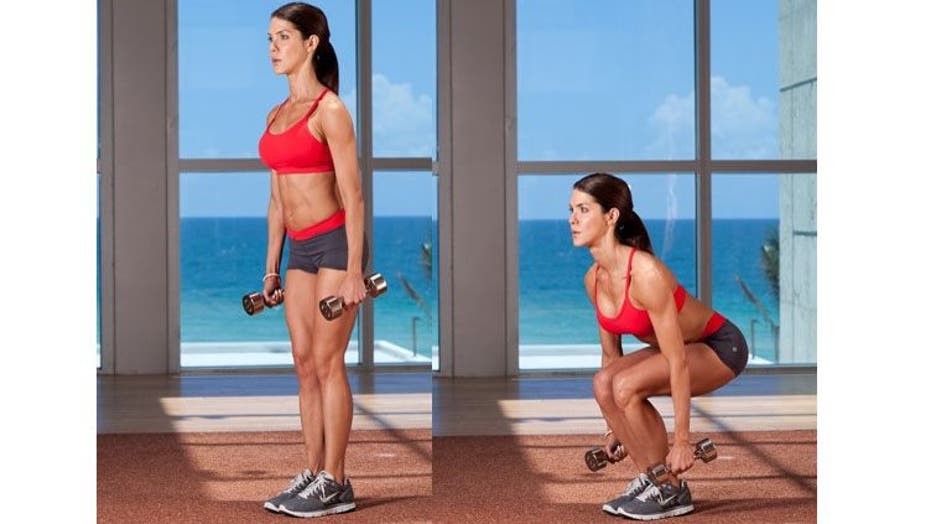The squat is the gold standard in resistance training. It impacts almost the entire muscular system while also affecting the cardiovascular system. If you don’t squat, add it as soon as possible to your regimen.
“This move helps to develop thoracic expansion, and therefore, respiratory capacity. It works the quadriceps, gluteal muscles, adductor group, erector spine, abdominal muscles and the hamstrings,” writes Frédéric Delavier in his book Strength Training Anatomy.
Even thought the squat is so highly regarded, for some reason there’s an erroneous idea that squats are for men (to build big legs) and lunges are for women (to get a great butt). Both are great no matter what your gender is.
A Strength and Flexibility Workout
These two moves taxes the entire leg musculature. Let’s go over some ways to emphasize some muscles more than others by changing foot and leg positioning. Lunges are not just for working the gluteus and it all depends on how you position your legs relatively to the body.
Here’s my easy-to-follow guide:
Squat:
Legs narrower than shoulder-width apart: Brian Biagioli, Ed.D., Executive Director NCSF, explains that a narrow stance reduces the base of support, and subsequent stability, while increasing the resistance arm. The greater range of motion (ROM) places more demands on the quads as the hips take longer to open for hip extensor (gluteus and hamstrings) contribution.
Legs wider than shoulder width apart: Juan Carlos Santana, director of the Human Institute Performance in Boca Raton, says that the wider position reduces flexion at the knees, while compromising the adductor muscles. Biagioli adds that this mechanical advantage allows for greater loads and places less demands on the back extensors as well.
Bottom line: When quadriceps development is the goal, go for the narrower squat. If you want to decrease the impact on the back while taxing the inside of the thigh muscles, you’ll be better off doing the wider squat.
Lunges:
Biagioli explains the differences among the most common lunges:
Dual leg static lunges increase isolated contribution from the hip and knee extensors (quadriceps and gluteus maximus mainly)
Forward lunge: lunge decelerates with the lower quad muscles and also employs these muscles for return acceleration.
Reverse lunges employ greater ROM and activation in the hip extensors due to the posterior movement of the femur. Increases gluteus and high hamstring recruitment.
Bulgarian squats or single-leg squat: The rear leg relies on a bench, which increases ROM in the hip flexors (quadriceps and anterior hip muscles) while placing a transitional load from the gluts high hamstrings and quadriceps.
Walking lunges: Santana says that this provides quite a balance load between the anterior and posterior leg muscles but due to the forward propulsion it may recruit more gluteus and hamstrings muscles.
Certainly, overall lunges exercises impose a demand on the hamstrings and gluteus, which women need to work more due to its naturally lower strength relationship between the quadriceps and the hamstrings to prevent knee injuries. However, some types of lunges add the elements of deceleration and propulsion, which are very important components for sports and for daily life activities that activate the quadriceps in a different way. The elements of balance and core stability are heavily involved and are also critical to physical activity.
In general, Delavier points out that a lunge executed with a small step predominantly works the quadriceps while a big step emphasizes the gluteus maximus.
Extra credit
If you already are a squat and lunge expert, consider throwing step-ups into the mix. Biagioli comments that when the step is high, it becomes a gluteus exercise but can migrate to greater quad and hamstring activity when the step is set below 90 degree angle.
Santana adds that “99 percent of the time this move is performed incorrectly. Most people push-off with the rear leg which defeats the stress on the muscles that you’re looking for. You need to push with the heel of the foot that you have on the bench.”
Marta Montenegro is an exercise physiologist, certified strength and conditioning coach and master trainer, who teaches as an adjunct professor at Florida International University. Marta has developed her own system of exercises used by professional athletes. Her personal website, martamontenegro.com, combines fitness, nutrition and health tips, exercise routines, recipes and the latest news to help you change your life but not your lifestyle. She was the founder of nationally awarded SOBeFiT magazine and the fitness DVD series Montenegro Method.
Follow us on twitter.com/foxnewslatino
Like us at facebook.com/foxnewslatino

